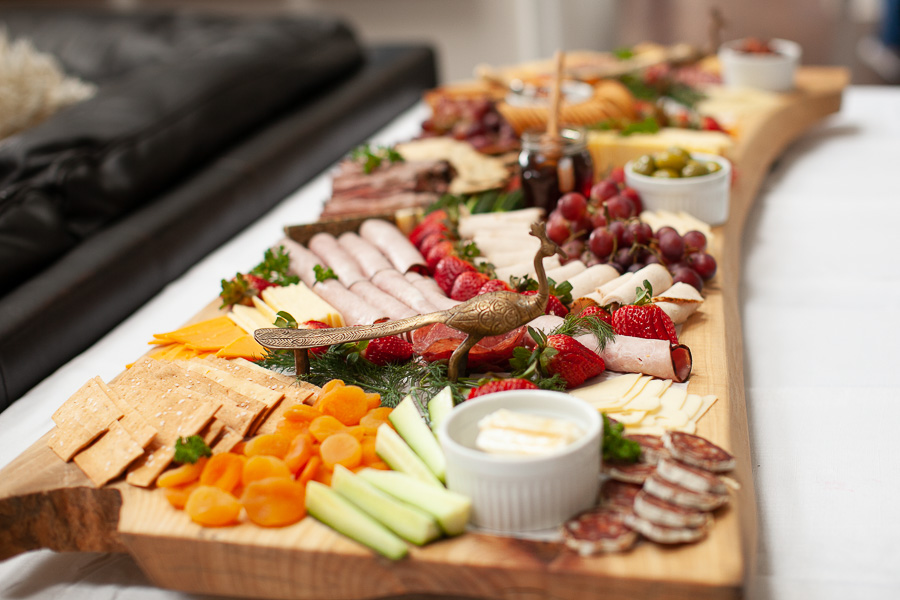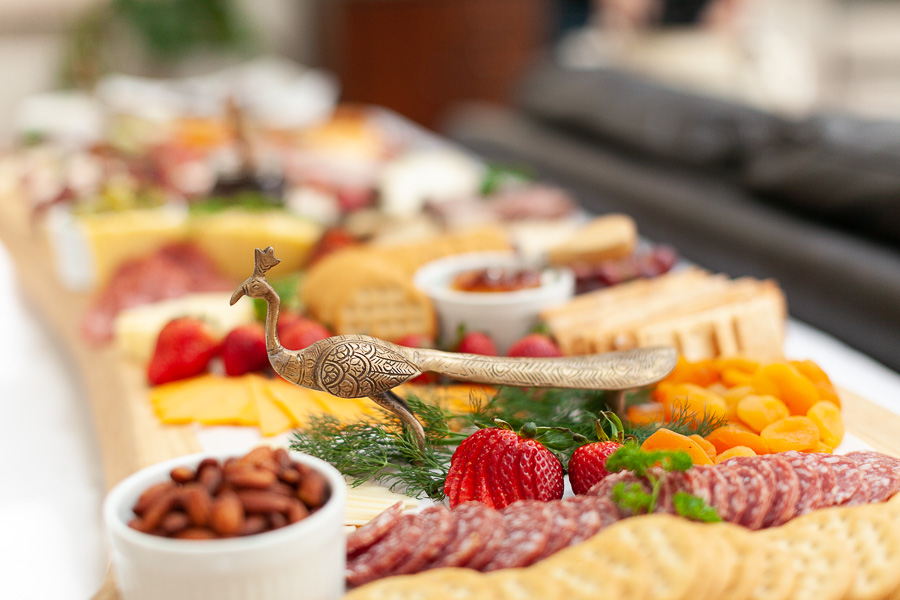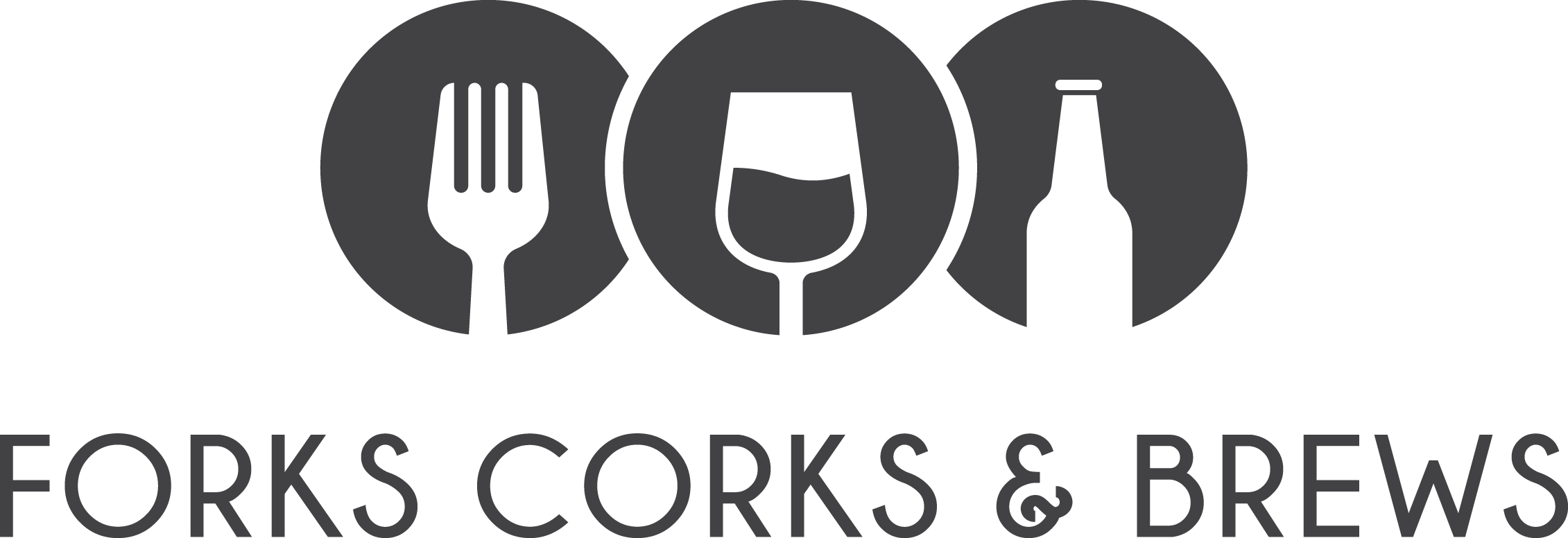Charcuterie (pronounced Shar-koo-dah-ree), a perfect meal that will enhance your entertaining abilities. Guests love the variety of food on a charcuterie board and hosts enjoy the flexibility of changing ingredients. Technically charcuterie means a selection of cured meats, but the idea of charcuterie has evolved quite a bit. Today customized charcuterie boards take the lead when it comes time to serve appetizers.
After a little research I learned that charcuterie comes from two French words: chair meaning “flesh” (or “meat”) and cuite meaning “cooked.” If you look up the French word chaircuite it means “cooked meat” and the word charcutier means butcher. Undoubtedly, charcuterie originally refered to meat.
With lavish displays of cheeses, cured meats, and fresh fruit and vegetables, charcuterie boards advanced into popular culture with good reason. These platters don’t require any culinary skills and you can adjust the ingredients to your food preferences. Also if you type “charcuterie” in any search engine, you will get over 50 million results relating to charcuterie. To sum it up anyone can make a customized charcuterie board with very little effort.

So how exactly do you make a charcuterie board?
A few of our favorite suggestions start with the actual board. Since we cater and throw a variety of events and parties, we have custom charcuterie boards in different sizes. We discovered that you want a board large enough to display all your goodies yet not so large that it looks like you don’t have much food. It’s a balancing act. This vintage charcuterie board can feed 30 people and is 4 1/2 feet by 1 1/2 feet.
Where to buy wood for a cheese board.
Now let’s talk about where to buy wood for a custom charcuterie. To begin the search for making a customizable charcuterie board start with the Internet. The web is a great resource for finding wood for a charcuterie board. Try these wood sites below to get started on finding wood for a charcuterie board.
If you live in San Diego, the San Diego Fine WoodWorkers Association can connect you with a community of skilled woodworkers, and they know a lot about wood. Any one of the association managers has the ability to help with what type of wood to use for a cheese and meat platter, or as we call it, a customized charcuterie board.
Another wonderful, sustainable resource for where to get wood for a charcuterie board is Lumbercycle. Lumbercycle’s mission is to reduce greenhouse gas emissions by making sure wood doesn’t get dumped into San Diego landfills. When green waste is dumped into landfills it produces methane, which is 25% more potent than the CO2 and carbon that would be released if it naturally decomposed or was burned.
Since we live in San Diego we provide resources from our home city. Please check your local area for wood resources. Again the Internet is a great tool to begin your search for charcuterie board wood.
In the meantime here are a few wood websites that can help you find wood for a customized charcuterie board: Reclaimed Wood San Diego, Made Lumber Supply, Th&h Hardwoods &n Hardware, Frost Hardwood.
Personalized charcuterie board with handles.
Some of our charcuterie boards have handles. Handles on a charcuterie board make it easy to transport and deliver. You can easily grab the handles on the cheese board and move it from the kitchen to the food display table. However, we recommend placing your charcuterie meats, cheeses, veggies and fruits on the charcuterie board exactly where you will be serving food.
As shown below our customized charcuterie boards have old world brass handles. Given that charcuterie dates back to the 15th century, we built our boards with vintage brass peacock handles to add visual interest with a traditional yet primitive look.

How to assemble a charcuterie board.
Now that you know where to buy wood for your customized charcuterie board, it’s time to think about your theme. Is this a dinner party, a wine and cheese tasting night, a vegetarian appetizer event, an anniversary party, a celebration for your new home, a football game spread, a dessert extravaganza, or something else? Believe us…any occasion calls for a customized charcuterie board and anyone can make one.
Let’s move on to the fun stuff. Decide what foods you want on your board. Do you want a traditional charcuterie board with meat and cheese? Have you thought about a veggie charcuterie board? Would you like to try something new and make a dessert charcuterie board? Think about what you want to eat and then decide if you want to stick to a charcuterie theme. Make your list, pick up your food, and get ready to have a good time decorating your board. Remember to make your charcuterie platter colorful!
Make your charcuterie board colorful.
Does your theme have a color scheme? You could pick foods that fit with those colors. Or you could use a variety of colors. Think about putting dark orange cheese wedges next to a pile of blueberries. Red radishes sliced thin look great next to vibrant green slices of zucchini. Try using big, juicy blackberries to separate crackers or cheese. Yellow, orange, or red pepper strips add a lovely pop of color if you place them next to something like bread or crackers, which don’t have much color.
Together with colorful vegetables we like to use fresh herbs such as dill, oregano, parsley and basil. In addition dried apricots, fresh strawberries, grapes and olives provide wonderful opportunities for color on a customized charcuterie board. Undoubtedly, there are endless ways to make a customizable charcuterie board.
Try our healthy avocado humus on your personal charcuterie board and pair it with cucumbers, carrots, or your favorite veggies. Personally, we love radishes and cucumbers on our charcuterie boards because they add a pop of color.
